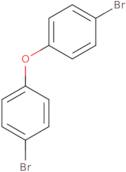Informations sur le produit
- 1,1'-Oxybis(4-Bromo-Benzene)
- 1,1'-Oxybis[4-Bromo-Benzen
- 1,1′-Oxybis[4-bromobenzene]
- 3,2′-Dibromodiphenyl ether
- 4,4'-Dibromo-diphenyl ether
- Bde 15
- Benzene, 1,1′-oxybis[4-bromo-
- Bis(4-Bromophenyl) Ether
- Bis(P-Bromophenyl) Ether
- Bis(bromophenyl) ether
- Voir d'autres synonymes
- Di(4-bromophenyl) ether
- Ether, Bis(4-Bromophenyl)
- Ether, bis(p-bromophenyl)
- NSC 1787
- NSC 9487
- Pbde 15
- p,p′-Dibromodiphenyl ether
- 4,4′-Dibromodiphenyl ether
Bis(4-bromophenyl)ether is an aromatic hydrocarbon that can be synthesized from the reaction of bromine and phenol. It is a dipole, which means it has a net electric charge on either side. The dipole is caused by the electron distribution in the molecule. Bis(4-bromophenyl)ether is synthesized through a debromination process, which involves the removal of one or more bromine atoms from a compound containing bromine. This process uses sodium hydroxide solution as a base. Bis(4-bromophenyl)ether has been identified as an environmental pollutant in some areas and has been shown to be toxic to aquatic life and carcinogenic to humans. Bis(4-bromophenyl)ether can also react with hydrogen sulfide in water to form bis(4-sulfonylphenyl)ether, which is used commercially as an analytical reagent for organic sulfur compounds such as





